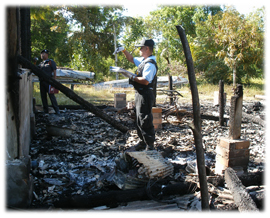Life on the thread for Thai Buddhists in the deep South
 The execution-style killing of four Thai Buddhists in Bacho district of Narathiwat on the night of Saturday September 18 represents a grim reminder of the life-threatening danger posed to most Buddhists who live in the three southernmost provinces.
The execution-style killing of four Thai Buddhists in Bacho district of Narathiwat on the night of Saturday September 18 represents a grim reminder of the life-threatening danger posed to most Buddhists who live in the three southernmost provinces.
The four victims were the last family of Thai Buddhists in Ban Hutae Lueyor in Village 6 of Tambon Bareh Tai. The other families had either moved out of the village for their own safety or killed by the militants.
Of all the 4,036 people killed in the strife-torn region for the past seven years, 1,658 of them were Buddhists and 2,263 Muslims. For the rest, their religious faiths could not be determined.
There were also 7,085 injured as a result of the conflict. Of these, 4,347 of them were Buddhists and 2,255 Muslims.
From the statistics of the casualties, it is clear that people of all religious faiths have been at risk and all of them have an equal chance of becoming a victim of the violence. But given the fact that Thai Buddhists account for less than 20 percent of the population of 1.8 million in the three Muslim-predominantly provinces, their casualties from the violence are shocking.
It is undeniable that the situation facing the Thai Buddhists in Yala, Pattani and Narathiwat plus four districts of Songkhla is critical especially in light of the truth that they have become a target of forced evacuation from the region by the militants.
A year ago in Bacho district of Narathiwat, militants shot dead six hunters for forest products – all of them Buddhists – while they were riding on a pick-up truck at the foot of the Budo mountain range. On March 14, 2007, militants stopped a passenger van shuttling between Hat Yai and Betong district of Yala and shot dead all the eight passengers who were Buddhists. The driver who happened to be a Muslim was spared his life by the murderers.
Between May and July this year, three people were killed and three others injured – all of them Buddhists – in a series of bomb explosions at rubber plantations in Tharnto district of Yala.
Tharnto district officer Surachai Wongsupalak said that militants’ harassment by means of shooting, arsoning or bomb attacks against Thai Buddhists in the district has been going on for years.
Back in 2006, he recalled that hundreds of Thai Buddhists who lived in Ban Santi 1 and 2 in Tambon Khern Bang Lang of Bannag Sata district and in Tambon Mae Wart of Tharnto district were forced to evacuate and to take temporary refuge at Wat Nirote Sangkaram in Yala’s Muang district for months after militants staged a shooting and arsoning spree.
The Isra news desk recently conducted a survey of Thai Buddhist communities in the region and managed to identify many communities under threats by the militants and forcing many residents to evacuate elsewhere for their safety.
In Yala province, the threatened communities include Samyaek Banniang in Muang district where many shops have been abandoned; several tambons in Bannang Sata and Tharnto districts; Tambon Talo Halo in Raman district where most Thai Buddhists have already moved out.
In Pattani, there are tambons Ban Nok, Ban Klang in Tambon Panareh of Panareh district; Tambon Pak Lo of Kok Po district.
In Narathiwat, most business areas are threatened. These include Ban Ton Sai community in Bacho district, Ban Dusongyor in Janeh district, Ban Lalo in Rueso district and Talad Tesaban community in Yee Ngor district.
Jiam Kongpetch, the surviving son of the ill-fated couple, Mr Chuen and Mrs Hong Kongpetch who were murdered by militants last Saturday September 18, said his family was the last Buddhist family in the village. He said his family refused to move out while all their neighbours had already evacuated because they loved their birth place. But after the deadly incident, he vowed not to return to the village again.
One businesswoman who refused to be identified said she lost her parents, a brother and two other relatives in the senseless violence. She said the Buddhists who still live in the region because they have no where else to go.
As for herself, she admitted that she was afraid but had to stay on because her family had been in the business for several generations. “Honestly, I have to pretend as if I am strong. But, privately, I cry all the time,” she said.
